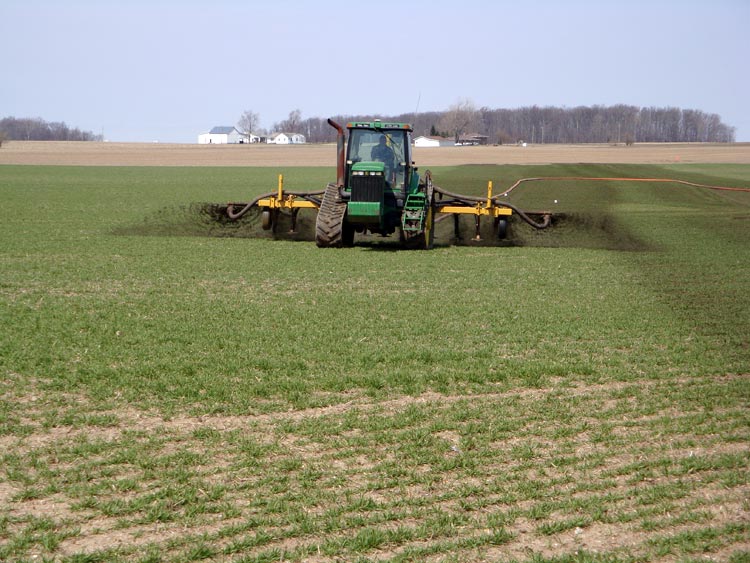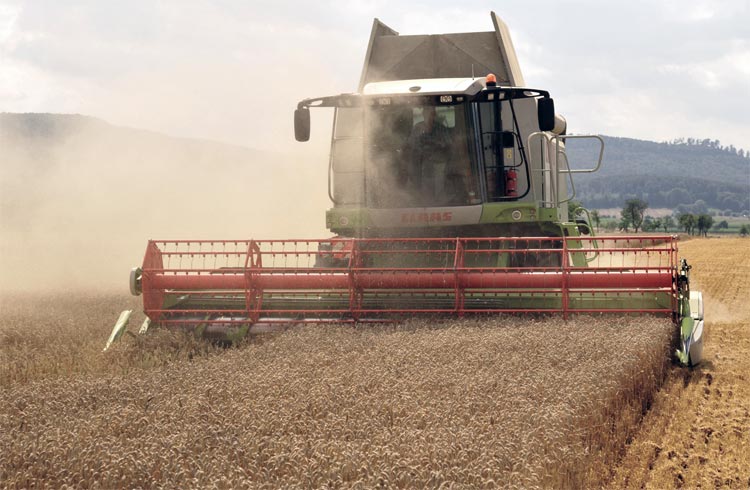The technology for growing winter wheat consists in observing all stages of sowing, fertilizing, choosing varietal seeds and acceptable predecessors, processing and proper collection. All of these factors affect profitability. And of course, weather conditions play a major role in shaping the harvest.
Winter wheat precursors
Winter wheat is quite whimsical to its predecessors, so you need to pay due attention to the crops that were planted on the soil before starting to work with it. Under various weather and climate conditions, the best predecessors will be those that do not deplete the soil, empty the fields early and leave fields clean of weeds.
- In the regions of the Steppe and Forest-Steppe, ideal predecessors are those that dry up the root layer of the soil to a lesser extent. The best precursor in this zone is black steam. It affects the reduction of weeds, the accumulation of moisture and nutrients. Such a crop will not only provide an increase in yield, but also improve the quality of the crop! In this zone it is also favorable to grow winter wheat after peas, corn, wheat (sown after black fallow). It is a bad idea to grow winter wheat after sorghum, Sudanese grass and sunflower. These crops vacate the field late and also dry up the soil to a critical depth.
- In the areas of Polesye, it would be an excellent option to sow winter wheat after such predecessors, which minimize weed clogging of the field, provide optimal sowing dates and a suitable nutrient regime (peas, perennial grasses and early potatoes).
Re-cultivation of winter wheat in the same field is allowed only after two years, because the soil must be cleared of various pests and diseases.
Soil tillage for winter wheat
The pre-sowing treatment of winter wheat should: ensure acceptable soil density, structure and aeration; ensure the preservation of moisture; remove weeds as much as possible, qualitatively close up plant residues and fertilizers; create an even seed bed for further placement of seeds at the desired depth.
Before starting processing, it is necessary to take into account the availability of the necessary machine and tractor equipment, climatic conditions, soil conditions. Much also depends on the predecessor. After non-steam predecessors, combined aggregates are used by non-moldboard tillage with a depth of 8-10 cm or 10-12 cm.
The subsowing layer should be sufficiently compacted, and the soil particles in it should be predominantly 1-3 mm. Breasts larger than 8 cm are already too much. Compliance with this condition will ensure good contact of seeds with the soil and simultaneous germination. Therefore, during seedbed preparation, cultivators must be equipped with harrows or kotka.
Since the soil surface must be level before sowing winter wheat, it must be leveled. The height of the ridges left after the cultivator should not differ by more than 2 cm. A level soil surface will ensure that the seeds are planted at a uniform depth.
Winter wheat fertilizer
Winter wheat responds favorably to fertilization. Basically, organic and mineral fertilizers are used for wheat. However, the introduction of organic fertilizers for winter wheat is permissible on those soils where part of the humus is less than 2%.
Winter wheat fertilizer:
- contribute to a more economical use of soil moisture;
- improve grain quality, increase yield;
- positively affect soil fertility;
- increase winter hardiness.
Fertilizer rates are calculated based on the need for nutrients to ensure better yields. For winter wheat, phosphate and nitrogen fertilizers play a special role.
Almost the entire rate of phosphorus-potassium fertilizers is applied before sowing winter wheat. The form of fertilizer is granular superphosphate. The remaining small part, approximately 10 kg/ha, is applied randomly during autumn feeding or by the root method in early spring.

Nitrogen fertilizers must be applied in several stages:
- Approximately 30 kg/ha of nitrogen fertilization in ammonia form is introduced during pre-sowing cultivation.
- Top dressing with nitrogen in the tillering phase will help increase the density of stems, height and fruitfulness of plants. Fertilizers do not affect the quality of grain crops. The application rate is 30-40 kg/ha, which is about 30% of the total calculated rate.
- At the beginning of piping, 50% of the total calculated nitrogen rate should be applied, which is approximately 60-75 kg / ha. This top dressing will help increase the yield, grain quality and will improve the granularity of the ear.
- 20% of nitrogen fertilizer from the norm is applied during heading-flowering. Most effectively, this bait manifests itself in an area with sufficient moisture.
If before sowing winter wheat there were stubble predecessors in the field or if the soil is not particularly rich in useful microelements, then nitrogen is recommended to be applied in the ammonium form. Thus, the fertilizer will be less washed out. In the Steppe zone, in order to improve the quality of grain during its formation and filling, foliar top dressing is used with an aqueous solution of carbamide. A fairly effective solution for crops is spraying with liquid complex fertilizers!
Selection of winter wheat seeds
Choosing high-quality varietal seeds of winter wheat is the key to a good harvest! It is the varietal seeds of winter wheat that fully utilize the fertility of the soil, which, under equal conditions, will provide the best yield of high-quality grain: up to 30% when compared with non-varietal seeds! Such seeds should have high sowing qualities: germination, germination energy, mass of a thousand seeds, moisture, absence of infection and weediness. Varietal seed material is freed from impurities that reduce its quality.
It is known that the climate of the area in which the crop is grown mainly affects the yield. That is why it is necessary to look closely at domestic varieties of wheat, as they are more adapted to soil standards and climatic features of the area. Analogues of an imported sample will not withstand winter weather so well, because they have reduced frost resistance.
It is necessary to take into account the risks, because it doesn’t happen once at a time, and if you sow one particular variety of winter wheat, the result will be worse than sowing several varieties that must be selected with different economic and biological properties.
Presowing treatment of winter wheat seeds
As a rule, the chemical treatment of seeds before sowing is divided into 3 stages:
- Conventional pickling;
- Seed encrustation;
Passing through each stage of processing before sowing, winter wheat increases in weight up to 20 times!
During dressing, the main thing is to choose the right and effective treater and dressing unit. For winter wheat, the following preparations will be effective:
- Raxil (Tebuconazole - 60 g / l) use rate - 0.4-0.5 l / t;
- Premis (Triticonazole - 200 g / l) use rate - 0.15-0.2 l / t;
- Vincit (Tiabendazole, flutriafol - 25 + 25 g / l) use rate - 1.5-2 l / t;
- Dividend Star (Difenoconazole, cyproconazole - 30 + 3.6 g / l) use rate - 1-1.5 l / t);
- Maxim (fludioxonil 25, g/l + tebuconazole, 15 g/l + azoxystrobin, 10 g/l) application rate - 1.5-1.75 l/t;
- Colfugo Super Color (Karbendazim - 200 g / l) use rate - 1.5-2 l / t.
Key features of protectants:
- homogeneous coating for grain;
- not difficult to use;
- safe transportation;
- long shelf life;
- the possibility of using in conjunction with other protectants;
- cheapness.
Almost the main problem that is associated with pickling is the poor adhesion of the active substance. This is especially noticeable during powder etchings. It is important that the dressing is not phytotoxic and does not interfere with normal seed germination.
How to sow winter wheat?
Sowing winter wheat can be done in different ways:
- ordinary lowercase (15 cm - row spacing);
- narrow row (7.5 cm - row spacing);
- cross (15 cm).
Usually use the normal string method. In order to obtain uniform seedlings, it is necessary to set the correct seeding depth: 3-4 cm - cultivated and moist soils; 1-2 cm - heavy soils; 6-8 cm - light soils. It should be borne in mind that the depth in the late sowing periods should be less than in the early ones.
The sowing rate of seeds can also vary depending on the timing of sowing the seeds. If the crops are early, then the best option would be 400-500 seeds per square meter. At the stage of collection, from this amount of seeds, 600-700 productive stems should be obtained. If the crops took place at the later stages, then it is necessary to increase the seeding rate by 10-15% per square meter. This is done in order to create the optimal number of productive stems per unit area.
Winter wheat harvest
Harvesting of winter wheat is carried out during the period of full maturity of grain (phase of wax ripeness of grain), when it reaches a moisture content of 14-17%. Preferably, the direct combining method is used. Grain losses should be kept to a minimum during harvesting.

If the crops are clogged, then they resort to a separate method of harvesting winter wheat, in which shedding occurs, and therefore losses increase. In this case, the moisture content of the grain should be within 30%. Also, a separate harvesting method is used in cases where the wheat is thick and tall.
Subsequently, after harvesting, the grain is cleaned. If necessary, it is passed through dryers and brought to a moisture content of 14%.
